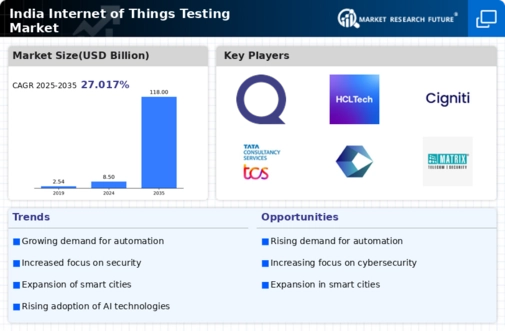Increased Investment in R&D
The surge in investment in research and development (R&D) within the IoT sector in India is a notable driver for the internet of-things-testing market. Companies are increasingly allocating resources to innovate and enhance their IoT offerings, which necessitates extensive testing to validate new technologies. The Indian government, along with private enterprises, is investing heavily in R&D, with estimates suggesting that the IoT sector could attract over $10 billion in investments by 2025. This focus on innovation creates a demand for specialized testing services that can ensure the reliability and performance of new IoT solutions. Consequently, the internet of-things-testing market is expected to benefit from this trend as organizations seek to maintain a competitive edge through rigorous testing.
Growing Cybersecurity Concerns
The escalating concerns regarding cybersecurity in India serve as a crucial driver for the internet of-things-testing market. With the rise in cyber threats targeting IoT devices, organizations are compelled to implement robust testing protocols to safeguard their systems. A report suggests that cyberattacks on IoT devices in India have increased by over 30% in recent years, highlighting the urgent need for effective security testing. This trend prompts businesses to invest in comprehensive testing solutions that can identify vulnerabilities and ensure data protection. As a result, the internet of-things-testing market is likely to expand as companies prioritize cybersecurity measures to protect their assets and maintain consumer trust.
Emergence of Industry Standards
The establishment of industry standards for IoT devices in India is becoming increasingly relevant, driving the internet of-things-testing market. As various sectors adopt IoT technologies, the need for standardized testing protocols to ensure interoperability and safety becomes apparent. Regulatory bodies are beginning to formulate guidelines that mandate compliance with specific testing criteria, which could potentially lead to a more structured testing environment. For instance, the Bureau of Indian Standards is working on frameworks that will require manufacturers to adhere to certain testing benchmarks. This regulatory push is likely to enhance the credibility of testing services, thereby fostering growth in the internet of-things-testing market as companies seek to meet these emerging standards.
Rising Adoption of Smart Devices
The proliferation of smart devices in India is a primary driver for the internet of-things-testing market. As households and businesses increasingly adopt smart technologies, the demand for rigorous testing to ensure functionality and security escalates. Reports indicate that the number of connected devices in India is expected to reach over 1 billion by 2025, necessitating comprehensive testing solutions. This surge in device adoption compels manufacturers to prioritize quality assurance, thereby expanding the testing market. Furthermore, the integration of IoT in sectors such as healthcare, agriculture, and manufacturing amplifies the need for specialized testing services. Consequently, the internet of-things-testing market is poised for growth as companies seek to mitigate risks associated with device failures and security breaches.
Government Initiatives and Support
Government initiatives aimed at promoting digital transformation in India significantly influence the internet of-things-testing market. Programs such as Digital India and Make in India encourage the development and deployment of IoT technologies across various sectors. The government has allocated substantial funding to enhance infrastructure and foster innovation, which indirectly boosts the demand for testing services. For instance, the allocation of over $1 billion for smart city projects necessitates rigorous testing to ensure the reliability of IoT applications. As these initiatives gain momentum, the internet of-things-testing market is likely to experience increased investment and growth, driven by the need for compliance with standards and regulations.


















Leave a Comment